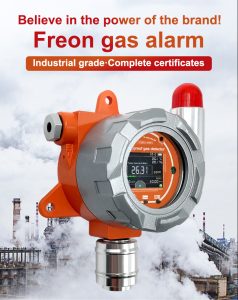Livestock welfare is a critical aspect of modern animal agriculture, as it not only affects the well-being of animals but also impacts productivity, product quality, and the sustainability of farming systems. Gas sensor technology has emerged as a valuable tool for monitoring and managing various gases in livestock environments, enabling farmers to optimize livestock welfare. This article explores the significance of gas sensor technology in optimizing livestock welfare, its applications in animal agriculture, and the benefits it offers to both farmers and animals.
- Gas Sensor Technology and Livestock Welfare: Gas sensors are devices designed to detect and measure the concentration of specific gases in the environment. In animal agriculture, gas sensor technology plays a vital role in monitoring gases such as ammonia (NH3), carbon dioxide (CO2), hydrogen sulfide (H2S), and methane (CH4) in livestock facilities. These gases can serve as indicators of air quality, ventilation effectiveness, and potential health risks for animals. By detecting and analyzing gas concentrations, gas sensor technology enables farmers to take proactive measures to optimize livestock welfare.
- Applications of Gas Sensor Technology in Animal Agriculture: 2.1. Air Quality Monitoring: Gas sensors are instrumental in monitoring air quality within livestock facilities. Ammonia is a common gas emitted from animal waste and urine that can negatively impact animal health. High ammonia concentrations can cause respiratory issues, eye irritation, and reduced growth rates in livestock. Gas sensors provide real-time data on ammonia levels, allowing farmers to take corrective actions such as adjusting ventilation, improving manure management, or modifying housing systems to maintain optimal air quality for animals.
2.2. Ventilation Management: Proper ventilation is essential for maintaining good air quality and temperature control in livestock facilities. Gas sensors can measure carbon dioxide levels, which indicate the adequacy of ventilation systems and the presence of metabolic waste products from animals. Monitoring CO2 concentrations allows farmers to ensure sufficient fresh air exchange, prevent heat stress, and minimize the risk of respiratory diseases in livestock.
2.3. Early Disease Detection: Gas sensor technology can aid in early disease detection by monitoring volatile organic compounds (VOCs) emitted by animals or associated with specific diseases. Changes in VOC emission patterns can serve as indicators of disease presence or animal stress. By continuously monitoring VOC levels using gas sensors, farmers can swiftly identify potential health issues, separate sick animals, and implement appropriate veterinary interventions, minimizing the spread and severity of diseases.
2.4. Environmental Control in Livestock Transportation: Gas sensors are valuable in monitoring and controlling environmental conditions during livestock transportation. As animals are transported over long distances, their welfare can be affected by factors such as temperature, humidity, and gas concentrations within the transportation vehicle. Gas sensors enable real-time monitoring of these conditions, allowing for timely adjustments to maintain a comfortable and safe environment for the animals during transit.
- Benefits of Gas Sensor Technology in Optimizing Livestock Welfare: 3.1. Improved Animal Health and Welfare: Continuous monitoring of gas concentrations using sensors helps identify potential health risks and allows prompt interventions to maintain optimal animal health and welfare. By ensuring good air quality, managing ventilation effectively, and detecting early signs of disease or stress, farmers can address issues proactively, reducing illness, mortality rates, and suffering among livestock.
3.2. Enhanced Productivity and Performance: Optimizing livestock welfare through gas sensor technology positively impacts productivity and performance. Animals raised in environments with improved air quality exhibit better growth rates, feed conversion efficiency, and reproductive performance. By optimizing ventilation, reducing ammonia levels, and promptly addressing health issues, farmers can enhance the overall productivity and profitability of their livestock operations.
3.3. Environmental Sustainability: Gas sensor technology promotes environmental sustainability in animal agriculture. By monitoring gas concentrations, farmers can implement targeted management practices to reduce emissions of gases such as ammonia and methane, which contribute to air pollution and greenhouse gas effects. Reducing emissions not only improves local air quality but also mitigates the environmental impact of livestock farming, contributing to sustainable farming practices.
3.4. Data-Driven Decision Making: Gas sensor technology provides valuable data that can be integrated with other farm management systems for informed decision making. By analyzing gas sensor data alongside other parameters, such as temperature, humidity, and animal performance records, farmers gain a comprehensive understanding of the livestock environment and can make data-driven decisions about ventilation strategies, dietary adjustments, or housing modifications.
- Integration and Challenges: Gas sensor technology can be integrated into existing livestock management systems through various means. Sensors can be installed in ventilation systems, feeding systems, or livestock transportation vehicles to continuously monitor gas concentrations. The data collected can be transmitted wirelessly to central control systems or cloud-based platforms for real-time monitoring and analysis.
Although gas sensor technology offers significant benefits, challenges remain. These include sensor accuracy, calibration, cost-effectiveness, data interpretation, and farmer education on sensor operation and maintenance. Continued research and development, along with industry collaboration, will address these challenges and improve the adoption and effectiveness of gas sensor technology in livestock farming.

Conclusion: Gas sensor technology plays a vital role in optimizing livestock welfare and promoting sustainable animal agriculture. Through continuous monitoring of gas concentrations, farmers can enhance air quality, manage ventilation effectively, identify early signs of disease, and maintain optimal environmental conditions for animals. The benefits of gas sensor technology include improved animal health and welfare, enhanced productivity, environmental sustainability, and data-driven decision-making. Integrating gas sensor technology into livestock management systems empowers farmers to optimize livestock welfare, resulting in healthier animals, improved productivity, and sustainable farming practices. Continued advancements in gas sensor technology and increased awareness among farmers will drive the widespread adoption of this technology, revolutionizing livestock welfare in animal agriculture.
 : +86 155 8830 2704
: +86 155 8830 2704 : jxdziot@gmail.com
: jxdziot@gmail.com
